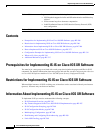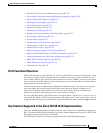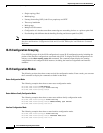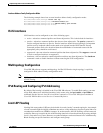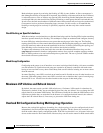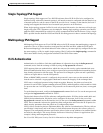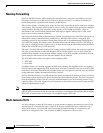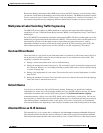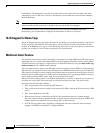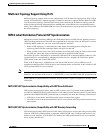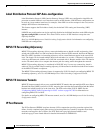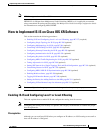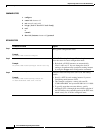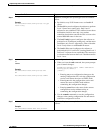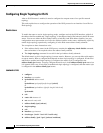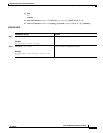
Implementing IS-IS on Cisco IOS XR Software
Information About Implementing IS-IS on Cisco IOS XR Software
RC-274
Cisco IOS XR Routing Configuration Guide
OL-14356-01
the backbone. The attached bit is usually set automatically as the router discovers other areas while
computing its Level 2 SPF route. The bit is automatically cleared when the router becomes detached
from the backbone.
Note If the connectivity for the Level 2 instance is lost, the attached bit in the Level 1 instance LSP would
continue sending traffic to the Level 2 instance and cause the traffic to be dropped.
To simulate this behavior when using multiple processes to represent the level-1-2 keyword
functionality, you would manually configure the attached bit on the Level 1 process.
IS-IS Support for Route Tags
The IS-IS Support for route tags feature provides the capability to associate and advertise a tag with an
IS-IS route prefix. Additionally, the feature allows you to prioritize the order of installation of route
prefixes in the RIB based on a tag of a route. Route tags may also be used in route policy to match route
prefixes (for example, to select certain route prefixes for redistribution).
Multicast-Intact Feature
The multicast-intact feature provides the ability to run multicast routing (PIM) when IGP shortcuts are
configured and active on the router. Both OSPFv2 and IS-IS support the multicast-intact feature. MPLS
TE and IP multicast coexistence is supported in Cisco IOS XR software by using the mpls traffic-eng
multicast-intact IS-IS or OSPF router command.
You can enable multicast-intact in the IGP when multicast routing protocols (PIM) are configured and
IGP shortcuts are configured on the router. IGP shortcuts are MPLS tunnels that are exposed to IGP. The
IGPs route the IP traffic over these tunnels to destinations that are downstream from the egress router of
the tunnel (from an SPF perspective). PIM cannot use IGP shortcuts for propagating PIM joins because
reverse path forwarding (RPF) cannot work across a unidirectional tunnel.
When you enable multicast-intact on an IGP, the IGP publishes a parallel or alternate set of equal-cost
next-hops for use by PIM. These next-hops are called mcast-intact next-hops. The mcast-intact
next-hops have the following attributes:
• They are guaranteed not to contain any IGP shortcuts.
• They are not used for unicast routing but are used only by PIM to look up an IPv4 next-hop to a PIM
source.
• They are not published to the FIB.
• When multicast-intact is enabled on an IGP, all IPv4 destinations that were learned through
link-state advertisements are published with a set equal-cost mcast-intact next-hops to the RIB. This
attribute applies even when the native next-hops have no IGP shortcuts.
• In IS-IS, the max-paths limit is applied by counting both the native and mcast-intact next-hops
together. (In OSPFv2, the behavior is slightly different.)



